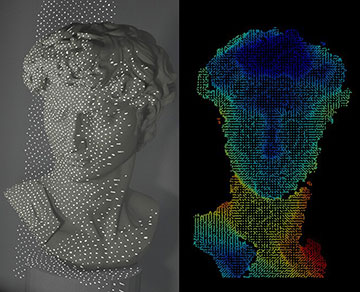A compact dot-projection system for facial recognition can accurately identify a 3D reproduction of Michelangelo's “David” [Image: Adapted from Nano Letters, 2024, DOI: 10.1021/acs.nanolett.3c05002]
Researchers in Taiwan have demonstrated that accurate facial recognition can be achieved with an optical system that is more than 200 times smaller than existing projector-based technologies (Nano. Lett., doi: 10.1021/acs.nanolett.3c05002). The streamlined platform replaces several optical components with a flat metasurface patterned with an array of nanopillars, and in tests, it was shown to perform just as well as current smartphone systems.
Bulky dot projectors
Most face recognition systems unlock secure devices or services by projecting thousands of infrared dots onto the face of the person who is looking at the screen. The device's camera is then used to read the pattern of dots, generating a facial map that can be compared with a reference image to confirm the owner's identity.
However, these dot projectors require multiple optical elements―including a laser array, several collimator lenses and a diffractive optical element that splits the light into the infrared dots―which makes them a bulky option for handheld and wearable electronics. While ultrathin optical elements based on metasurfaces offer an attractive solution, compact integration has so far been hindered by the lack of surface-emitting lasers that deliver a narrow enough beam to avoid the need for collimating optics.
Simpler metasurface architecture
In this new design, the researchers overcame that problem by designing a metasurface to work in tandem with a single photonic-crystal surface-emitting laser (PCSEL). The metasurface is created by etching a pattern of square nanopillars onto the surface of a gallium–arsenide substrate, while the PCSEL generates a highly collimated beam with enough power to be scattered by the metasurface into more than 45,000 infrared dots. As with a conventional system, a built-in camera can then be used to read the pattern of dots and match it to a pre-existing image.
This simplified optical architecture yields an integrated system that measures less than 300 µm across.
This simplified optical architecture yields an integrated system that measures less than 300 µm across, with a surface area some 230 times smaller than that of a conventional dot projector. Replacing an array of lasers with a single PCSEL also lowers the overall power consumption by a factor of 10.
The researchers showed that their prototype system could accurately identify a 3D replica of Michelangelo’s “David” by comparing the infrared dot patterns produced by the device to online photos of the famous statue. According to the team, the same approach could provide power-efficient solutions with the small form factors needed for widespread adoption in wearable electronics and robotics.

